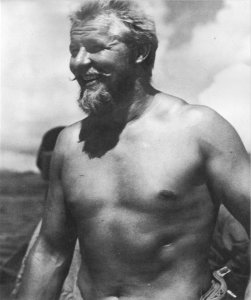![]() The Pacific War Online Encyclopedia
The Pacific War Online Encyclopedia
|
| Previous: Underhill, James L. | Table of Contents | Next: Unicorn, British Light Carrier |

U.S. Navy. Via ibiblio.org
Underwater demolition teams (UDTs) were first
organized in the Pacific following the Tarawa
invasion, when failure
to anticipate the difficulty of crossing the reef to the invasion
beaches led to heavy casualties.
Each team consisted of 15 officers
and
75 men, mostly selected from Navy construction
and engineering units, but with
a few members of Naval Combat Demolition Teams that had been training
for the Normandy invasion in Europe. Initially two teams were
organized, but by the end of the war their number would increase to 34.
They first saw combat in the Marshalls
invasion in January 1944.
UDTs were tasked with clearing the way for landing
craft. This entailed neutralizing mines
and landing obstacles and
clearing channels through reefs. Surprisingly, training initially
emphasized the use of rubber rafts
and avoiding the need to enter the water. It was quickly
discovered that men wearing helmets
and full battle dress paddling rubber rafts could not get close enough
to shore for a thorough reconnaissance.
As a consequence, Naval Combat
Swimming was added to the tactics and training of the UDTs, and a
candidate had to be capable of swimming two miles to qualify. Team
members became expert at swimming wearing only face masks, swim trunks,
and shoes. This worked well so long as the UDTs were operating in warm
southern waters, but as the American offensive moved north towards Japan, the UDTs faced the challenge of
operating in cold water where there was danger of hypothermia and
severe cramps. The use of wet suits was not
introduced until long after the war ended.
UDTs were typically transported to the objective
on destroyer-transports,
each of which could carry one or two teams. The frogmen would then
transfer to their rubber boats for the final approach to the beach.
The principal equipment of the UDTs was 20-pound rubber tubes of tetryl explosive that could be easily emplaced around obstacles for demolition. The UDTs also used blocks of tetryl wound with primer cord and soft wire and carried in a "Schantz pack", a kind of fabric apron with flotation bladders and four pockets for charges. Charges were attached using the metal wire and the primer cord was run to a main trunk leading to the fuse. Each charge was capable of bringing down a wooden post a foot in diameter.
Although the main mission of UDTs was clearing
obstacles with explosives, they had an important secondary mission of
scouting enemy positions close to shore. UDTs returning from a mission
were immediately debriefed by intelligence
officers, who then passed the information to landing force commanders. Because sufficiently
effective reconnaissance could not be carried out at night, the UDTs
operated in daylight under cover of 40mm fire from LCI gunboats. Team members painted
rings on their bodies at one foot (30 cm) intervals to help estimate
water depth, and they carried a stylus and plastic square to make
waterproof notes.
Postwar most of the UDTs were disbanded, leaving
just two on each coast. These became the ancestors of today's Navy
SEALs.
References
Morison
(1953)
National Navy
UDT-SEAL Museum (accessed 2008-1-19)
The Pacific War Online Encyclopedia © 2008-2009, 2011 by Kent G. Budge. Index